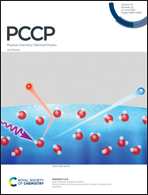Explicit solvent theory of salt-induced dielectric decrement†
Abstract
We introduce a field-theoretic electrolyte model composed of structured solvent molecules and salt ions coupled by electrostatic and hard-core (HC) interactions. Within this explicit solvent framework, we characterize the salt-driven dielectric decrement by including salt–solvent correlations beyond weak-coupling (WC) electrostatics. The WC approximation of prior formalisms is relaxed by treating the salt charges via a virial expansion. This virial approach enables the explicit inclusion of the many-body salt–solvent interactions, and directly leads to the experimentally observed linear decay of the electrolyte permittivity with added dilute salt. The permittivity formula emerging from our approach indicates that the reduction of the solvent permittivity is induced by the salt screening of the polarization charges suppressing the dielectric response of the solvent. By comparison with experiments, we also show that the salt-dressed permittivity formula can equally reproduce the attenuation of the electrolyte permittivity with rising temperature, the thermal decay of the dielectric decrement, and its intensification with the salt valency. In accordance with the observation of previous numerical simulations and implicit solvent theories, the consistent qualitative agreement of our theory with this wide range of experimental trends points out the electrostatic ion–solvent correlations as the primary mechanism behind the salt-induced dielectric decrement.



 Please wait while we load your content...
Please wait while we load your content...